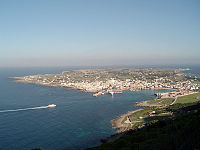Favignana
| Favignana | |
|---|---|
| City | Comune di Favignana |
| Region | Sicily |
| Province | Trapani (TP) |
| Altitude | 6 |
| Area cityproper | 37 |
| Population as of | 2001 |
| Population density | 4,106 |
| Population density metric | 111 |
| Timezone | CET, UTC+1 |
| Map x | 37.931 |
| Map y | 12.329 |
| Frazioni | Levanzo, Marettimo |
| Telephone | 0923 |
| Postal code | 91023 |
| Gentilic | Favignanesi |
| Saint | |
| Day | |
| Mayor | Gaspare Ernandez (since May 27, 2003) |
Favignana (Italian: Isola di Favignana) is an island and a commune of the Aegadian Islands. It is situated approximately 7 km (4.5 miles) west of the coast of Sicily, between Trapani and Marsala, the coastal area where the Stagnone Lagoon and the international airport of Trapani, are sited.
The island is famous for its tuna fisheries and is now a popular tourist destination with frequent hydrofoil connections to the mainland.
History
In ancient times Favignana was called Aegusa, meaning "goats' island". The present name is derived from Favonio, an Italian name for the Föhn wind. It was colonised by the Phoenicians, who used it as a stopping point on their trans-Mediterranean trading routes.
The island was fought over during the First Punic War between Rome and Carthage. On 10 March 241 BCE, a major naval battle was fought a short distance offshore between the two powers. Two hundred Roman ships under the consul Gaius Lutatius Catulus met and decisively defeated a much larger Carthaginian fleet of 400 ships, with the Romans sinking 120 Carthaginian vessels and taking 10,000 prisoners. So many dead Phoenicians washed ashore on the northeastern part of Favignana that the shoreline there acquired the name "Red Cove" (Cala Rossa) from the bloodshed. The Romans took possession of the island under the terms of the treaty that ended the war.
Under Roman rule, the islanders adopted Christianity by the 4th century CE, although (judging by inscriptions dated to the 1st century BCE) they appear to have retained at least some Phoenician culture. Favignana fell to the Saracens following the fall of Rome and was used as a base for the Saracen invasion of Sicily. The Normans subsequently took possession of the island in support of their own invasion, and built fortifications there. Under the Aragonese rulers of Sicily, Favignana and the other Egadi Islands were hired out to Genoese merchants and in the 15th century the islands were granted to one Giovanni de Karissima, who adopted the grand title "Baron of Tuna".
The plentiful tuna fish found offshore were first exploited systematically under the Spanish from about the 17th century onwards. Facing severe financial problems from their ongoing wars, the Spanish sold the islands to the Marquis Pallavicino of Genoa in 1637. The Pallavicini substantially developed the economy of the island, prompting the establishment of the modern town of Favignana around the Castello San Giacomo. In 1874, the Pallavicino family sold the Egadi Islands to Ignazio Florio, the son of a wealthy mainland industrialist, for two million lire. He invested heavily in Favignana and built a major tuna cannery on the island, bringing prosperity to many of the inhabitants. Tufa quarries were also opened with stone being exported to Tunisia and Libya.
The islanders had a much more difficult time during the 20th century. Favignana's economy slumped between the two World Wars and many inhabitants emigrated to the mainland and abroad. The tuna fishery also declined with the rise of factory fishing after the Second World War. However, the island's fortunes were turned around by the advent of tourism from the late 1960s onwards.
Geography
Favignana is the largest of the three principal Egadi Islands, with a land area of 37 km². The island is often described as having a "butterfly" shape. Favignana town is located on a narrow isthmus connecting the two "wings", which have quite different characteristics. The eastern half of the island is largely flat, while the western half is dominated by a chain of hills of which Monte Santa Caterina is the tallest at 314 m (1045 ft). It is topped by a fort, originally established by the Saracens and still in use by the Italian military (and closed to the public). A number of small islands are situated off the south coast of Favignana.
Sights
The island is famous for its caves of volcanic rock and the ancient fishing technique of tonnara, originally of Arab origin, with the trapping and mattanza (massacre) of bluefin tuna. Favignana is one of the few places in Italy where this is still done. Due to its volcanic nature, there are few beaches on the island; however, it is a popular site for scuba diving, snorkeling, and for day trips from nearby Trapani.
Further reading
- Mattanza by Theresa Maggio (ISBN 0141001607), An American writer's account of the Favignana's springtime tonnara.
